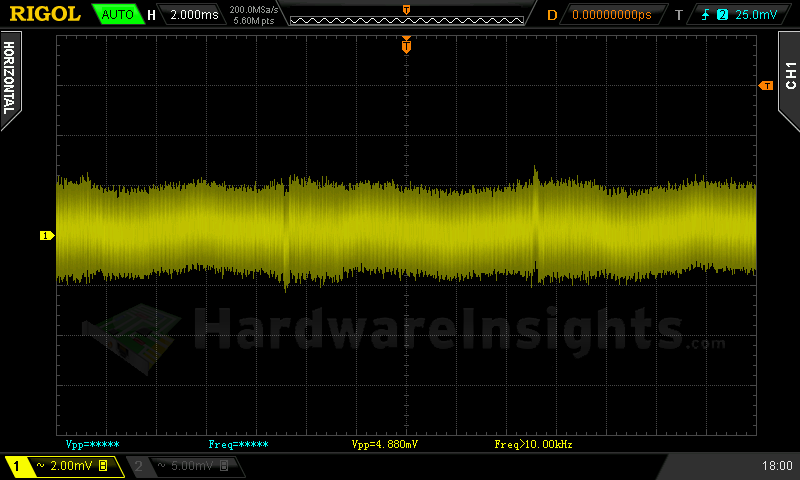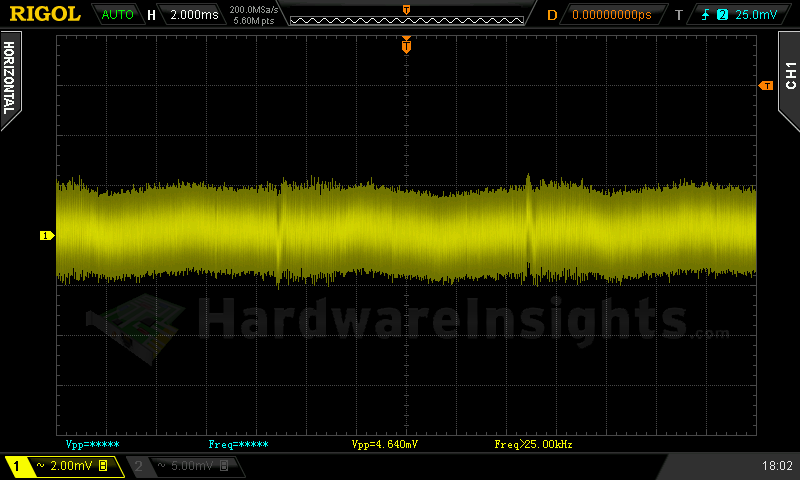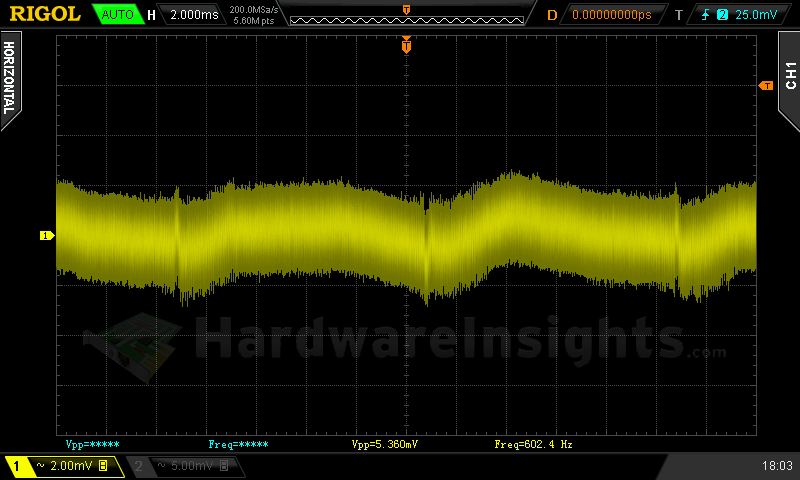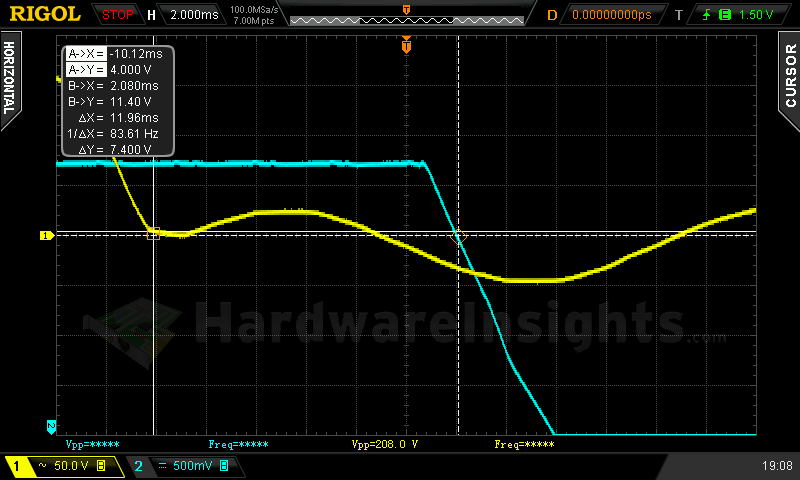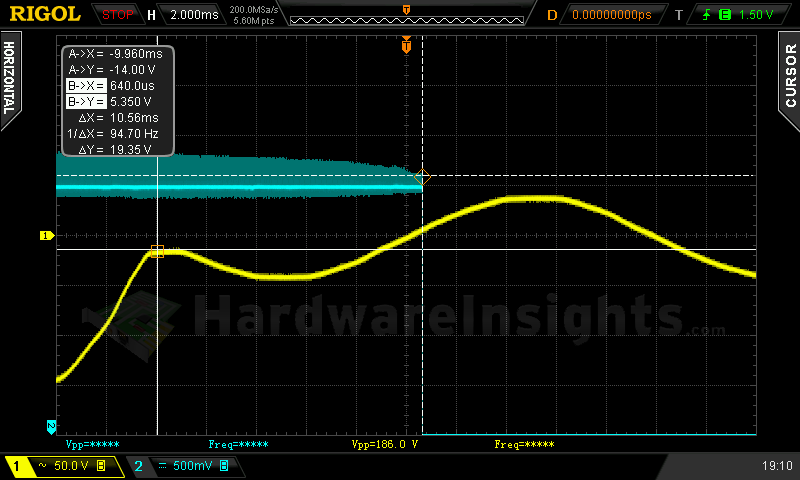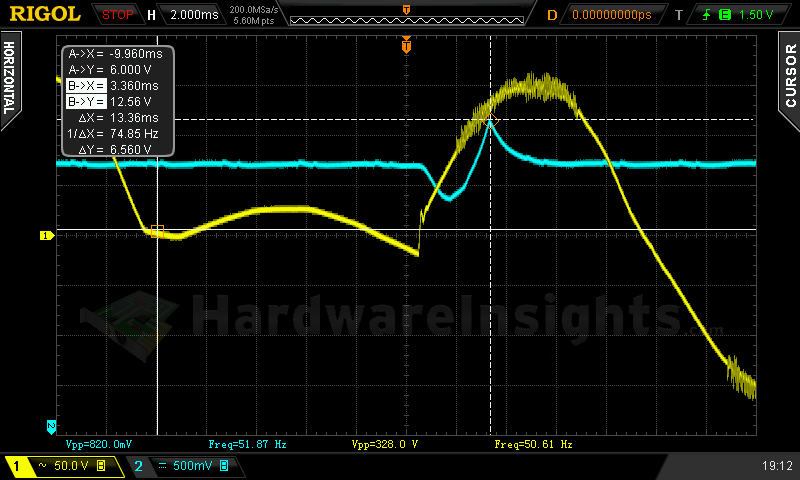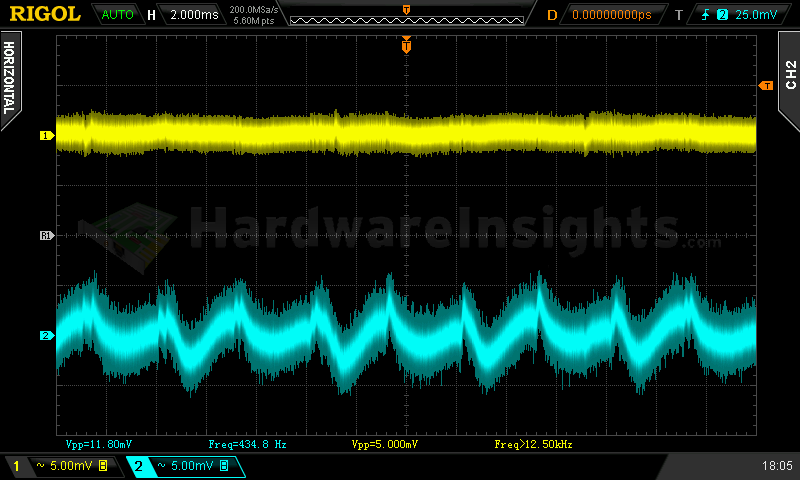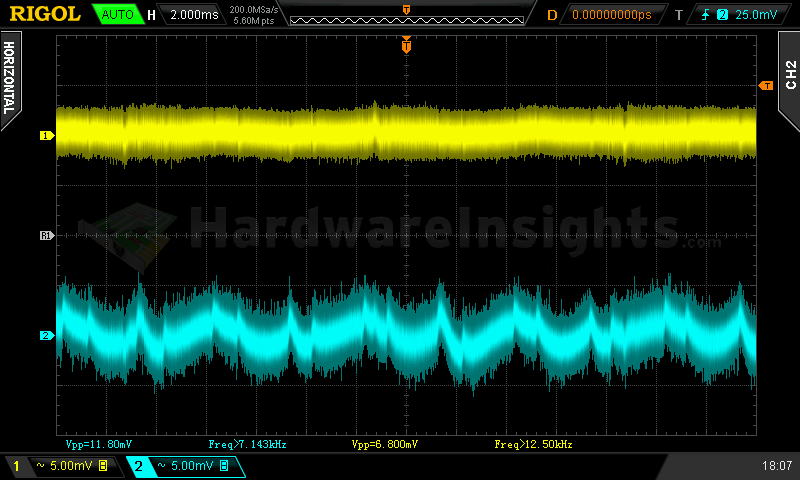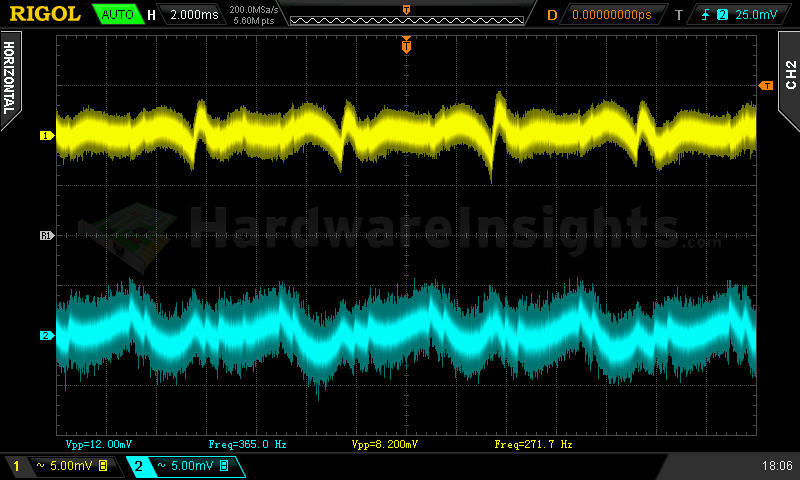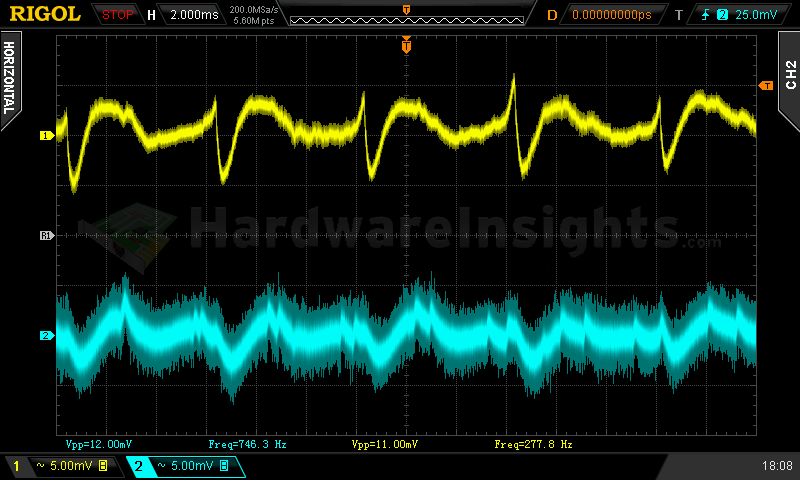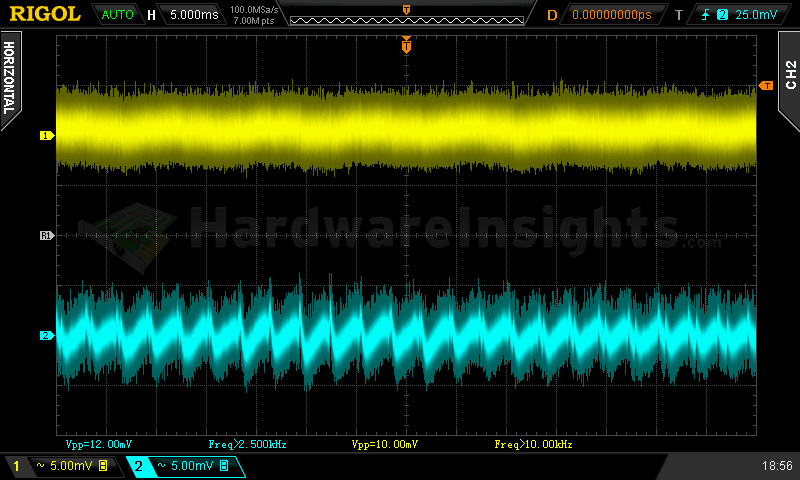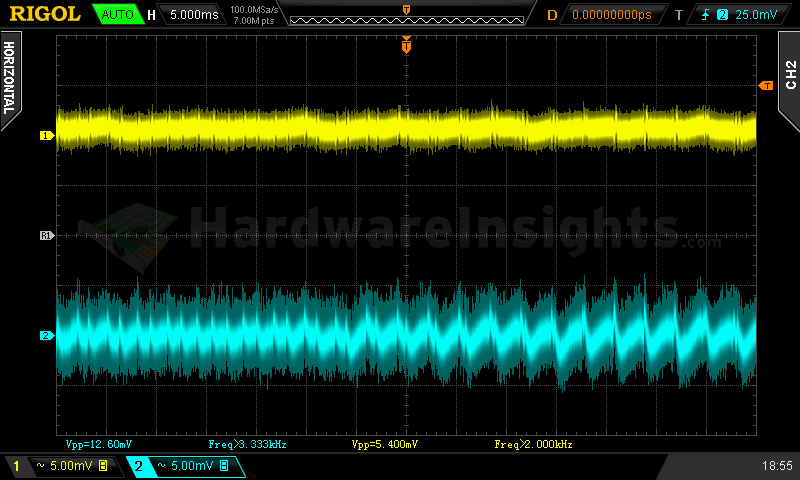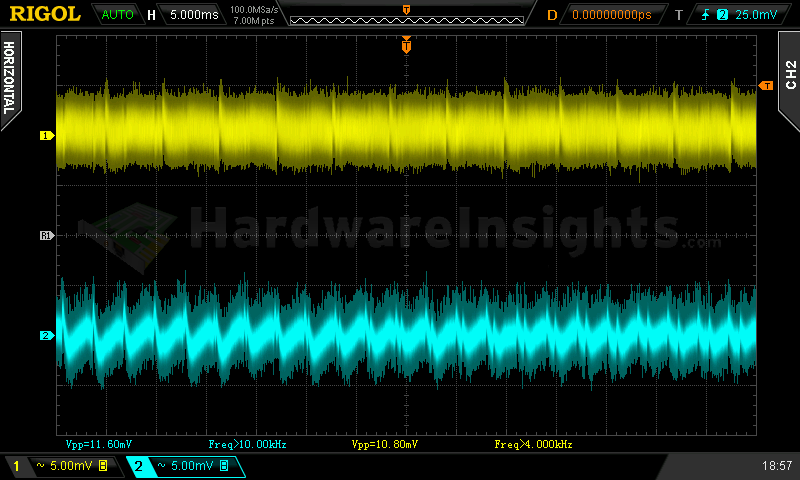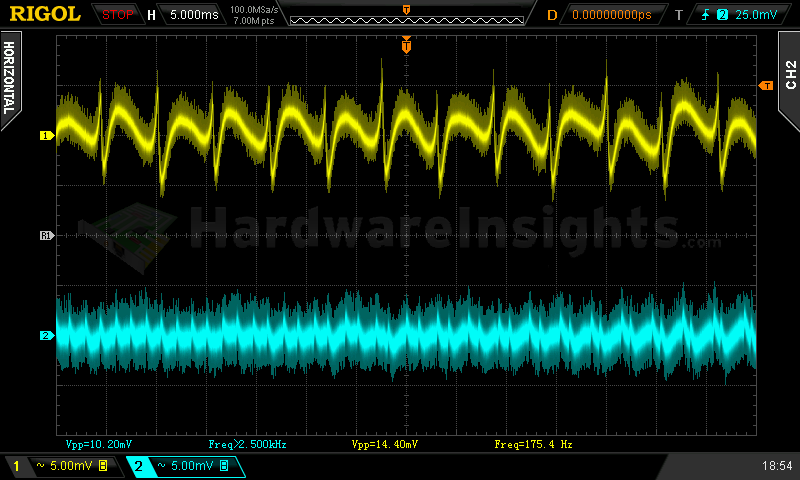Contents
- 1Introducing the Topower SilentEZ 350W
- 1.1Packaging and accessories
- 2Connectors & cabling
- 2.1Casing & cooling
- 3Input filtering
- 4Primary side
- 4.1+5 V stand-by rail
- 5Secondary side
- 5.1Build quality
- 6Load testing
- 6.1Loading +5 V SB
- 6.2Hold-up time
- 6.3Combined loading
- 6.4Combined loading ripple
- 6.5Crossloading, overloading
- 6.6Crossloading, overloading ripple
- 6.7Fan speed, temperatures and noise
- 7Conclusion and evaluation
- 7.1Thanks
- 7.2Discussion
Load testing
Loading +5 V SB
As always, all load testing is done according to our testing methodology. The voltage regulation and ripple suppression is quite nice. Efficiency is just about average, slightly over 70 %. However, it still has no-load consumption of 0.69 W. That would pass the first regulation with maximum of 1.0 W, but not the later one which lowers that to 0.5 W. So at this moment, the Topower SilentEZ 350W also does not comply with EUC order 1275/2008 thus it has no place on the current market. Either newer SB controller, or some of those microchips which cut “phantom power” losses would solve that.
| Output (W) | Load (A) | Voltage (V)/ ripple (mV) | Input (W) | Efficiency/power factor |
| 0 | 0 | 5.183/4.880 | 0.69 | —/0.037 |
| 12.75 | 2.49 | 5.128/4.640 | 17.74 | 71.9 %/0.504 |
| 17.81 | 3.49 | 5.109/5.360 | 25.41 | 70.1 %/0.559 |
+5 V SB ripple (left to right): 0 A; 2.49 A; 3.49 A
Hold-up time
As we can see on the oscilloscope screenshot, the hold-up time of the SilentEZ 350W +12 V rail appears to be just barely over 10 ms at 11.96 ms. Considering how small the input capacitor is, I must admit I expected even worse. Not that it changes the fact the ATX states minimum of 17 ms…
The hold-up time of the power good signal is shorter as it should, but still over 10 ms, 10.56 ms to be exact. Notice the terrible high-frequency noise of the signal; most of it is filtered away with 20MHz bandwidth limiter.
While interrupting the power for a given time, I found the +12V rail voltage was somewhat overshooting. At exactly 10.5 ms the unit still makes it in spec. Seems that them guys in Topower set lower goal for hold-up time, but they actually engineered this unit well enough so it passes on it, and this was almost a decade ago. Interesting how some others have problems with that today…
Combined loading
Combined loading was OK for the Topower SilentEZ 350W. The voltage regulation is just within 5 % so nothing spectacular, but load regulation is nice. All the voltages start higher and do not fall under nominal even under full load so it is not so bad.
| Output power | Load/ voltage +5 V SB | Load/ voltage +3.3 V | Load/ voltage +5 V | Load/ voltage +12 V | Load/ voltage −12 V | Input power | Efficiency/ power factor |
| 7.8 %/ 27.42 W | 0 A/ 5.171 V | 0.009 A/ 3.421 V | 0.303 A/ 5.214 V | 1.836 A/ 12.253 V | 0.293 A/ −11.426 V | 44.22 W | 62.0 %/ 0.841 |
| 20 %/ 68.02 W | 0.550 A/ 5.164 V | 1.490 A/ 3.403 V | 1.500 A/ 5.196 V | 3.97 A/ 12.310 V | 0.297 A/ −11.585 V | 91.99 W | 73.9 %/ 0.962 |
| 40 %/ 141.69 W | 1.050 A/ 5.152 V | 2.89 A/ 3.381 V | 2.24 A/ 5.206 V | 9.14 A/ 12.187 V | 0.298 A/ −11.644 V | 180.0 W | 78.7 %/ 0.986 |
| 60 %/ 210.86 W | 1.56 A/ 5.142 V | 4.06 A/ 3.366 V | 3.41 A/ 5.207 V | 14.27 A/ 12.108 V | 0.306 A/ −11.709 V | 274.8 W | 78.5 %/ 0.992 |
| 80 %/ 276.01 W | 1.95 A/ 5.133 V | 5.49 A/ 3.359 V | 4.93 A/ 5.198 V | 18.06 A/ 12.093 V | 0.301 A/ −11.791 V | 353.0 W | 78.2 %/ 0.993 |
| 100 %/ 348.88 W | 2.45 A/ 5.119 V | 8.36 A/ 3.344 V | 6.81 A/ 5.183 V | 22.3 A/ 12.087 V | 0.300 A/ −11.903 V | 460.8 W | 75.7 %/ 0.994 |
The efficiency indeed peaks at close to 80 %, with my currently low efficiency measurement accuracy I think it can indeed top at 80 %. For the price this is OK.
Combined loading ripple
The ripple values of the Topower SilentEZ 350W are surprisingly outstanding. The unit does not push efficiency, switching frequency and voltage regulation too far, plus the filtering is there, so that may be the reason why the results are so nice.
| Output % | Ripple +5 V SB | Ripple +3.3 V | Ripple +5 V | Ripple +12 V | Ripple −12 V |
| 7.8 | 5.000 mV | 6.800 mV | 8.200 mV | 12.00 mV | 11.00 mV |
| 20 | 4.400 mV | 6.200 mV | 5.400 mV | 13.80 mV | 11.80 mV |
| 40 | 5.000 mV | 4.800 mV | 7.000 mV | 12.00 mV | 13.80 mV |
| 60 | 5.600 mV | 5.600 mV | 5.000 mV | 12.40 mV | 13.40 mV |
| 80 | 7.400 mV | 7.000 mV | 5.800 mV | 11.80 mV | 13.40 mV |
| 100 | 10.00 mV | 5.400 mV | 10.80 mV | 12.60 mV | 14.40 mV |
Ripple 7.8% load (left to right): +5 V SB; +3.3 V; +5 V; −12 V. The second channel is connected to +12 V.
Ripple 100% load (left to right): +5 V SB; +3.3 V; +5 V; −12 V. The second channel is connected to +12 V.
Crossloading, overloading
Crossloading tests were the worst, as could be expected from group design. Interestingly, the +3.3V rail fell down the toilet and was close to unable to even provide the current because as the load increased, the voltage and current decreased. I think the inductor which has winding from three stranded thin wires instead of single thick plays a role in that. Also with +5V rail crossload the +12V load went through the roof, as usual. Even with increased +12V load it stayed over 13 V, this is just a big NO and FAIL on crossload voltage regulation.
| Output power | Load/ voltage +5 V SB | Load/ voltage +3.3 V | Load/ voltage +5 V | Load/ voltage +12 V | Load/ voltage −12 V | Input power | Efficiency/ power factor |
| 27 %/ 95.63 W | 0.544 A/ 5.170 V | 19.8 A/ 2.943 V | 1.485 A/ 5.180 V | 1.876 A/ 12.392 V | 0.312 A/ −11.543 V | 143.6 W | 66.6 %/ 0.981 |
| 36 %/ 126.39 W | 0.543 A/ 5.166 V | 1.48 A/ 3.390 | 17.7 A/ 5.004 V | 2.006 A/ 13.087 V | 0.308 A/ −12.222 V | 167.2 W | 75.6 %/ 0.985 |
| 84 %/ 293.85 W | 0.552 A/ 5.163 V | 1.47 A/ 3.371 V | 1.53 A/ 5.266 V | 23.40 A/ 11.733 V | 0.299 A/ −11.583 V | 379.8 W | 77.4 %/ 0.993 |
| 115 %/ 403.15 W | 2.44 A/ 5.118 V | 9.67 A/ 3.339 | 7.96 A/ 5.179 V | 26.0 A/ 12.058 V | 0.305 A/ −11.973 V | 569 W | 70.9 %/ 0.993 |
As for protections, man, this thing is more lucky than properly engineered I guess. First, under overload, I could only pull rated power from the VIPer22A as it was shutting down. The unit itself only delivers slightly over 400 W before OPP kicks in, I would not push it further, it was hot like hell and the primary switchers are only 9A after all. Efficiency dropped significantly with most of these tests.
Crossloading, overloading ripple
Here the ripple was pretty much the same, with the exception of +3.3V rail under crossload.
| Output % | Ripple +5 V SB | Ripple +3.3 V | Ripple +5 V | Ripple +12 V | Ripple −12 V |
| 27 | 5.000 mV | 16.00 mV | 6.400 mV | 9.800 mV | 15.60 mV |
| 36 | 7.600 mV | 4.800 mV | 5.200 mV | 8.000 mV | 13.20 mV |
| 84 | 5.200 mV | 4.400 mV | 6.800 mV | 8.000 mV | 12.00 mV |
Fan speed, temperatures and noise
The fan inside the Topower SilentEZ 350W started spinning right when the unit powered on. It ran on very low speed almost the whole time (besides when the switch was toggled), compared to the outcoming air temperatures that is. Something on the secondary side was terribly overheating, as you can see the temperatures easily reached 50-60 °C. It was of course smelling badly just by test four as it was so hot. In my opinion the fan needs totally different hysteresis, or keep running on full speed. Around 900 RPM it gets noticeable by ear (at 38.8 dBA ambient) and at 1200 RPM it is already noisy. Over 1400 it’s just a turbine.
| Output % | Fan speed (RPM) | Temperature intake/ outtake | Noise (dBA) |
| 7.8 | 654/1746 | 23 °C/ 25 °C | 38.9/43.7 |
| 20 | 690/1800 | 23 °C/ 32 °C | 38.9/44.7 |
| 40 | 694/1812 | 24 °C/ 37 °C | 38.9/44.7 |
| 60 | 690/1811 | 24 °C/ 47 °C | 38.9/44.7 |
| 80 | 876/1836 | 26 °C/ 51 °C | 39.1/44.7 |
| 100 | 1228/1887 | 25 °C/ 58 °C | 39.9/45.1 |
| CL 27 | 763/1821 | 25 °C/ 48 °C | 39.0/44.7 |
| CL 36 | 765/1955 | 25 °C/ 40 °C | 39.0/46.3 |
| CL 84 | 941/1806 | 26 °C/ 54 °C | 39.2/44.7 |
| OL 115 | 1482/1852 | 26 °C/ 60 °C | 40.9/44.8 |
I even put the SilentEZ 350W to the sweater and it survived likely only thanks to another of the VIPer22A embedded protections, this time OTP. After 9 minutes it shut down, I think it would manage few more minutes, but likely not whole 15. This thing will barely survive the warranty with the temps it runs at. And that chloroprene glue, which hates heat, oh man. I think maximum 200 W and bottom-mounted position is the only condition which would be safe.
